engine coolant YAMAHA TMAX 2002 Owners Manual
[x] Cancel search | Manufacturer: YAMAHA, Model Year: 2002, Model line: TMAX, Model: YAMAHA TMAX 2002Pages: 102, PDF Size: 1.67 MB
Page 20 of 102
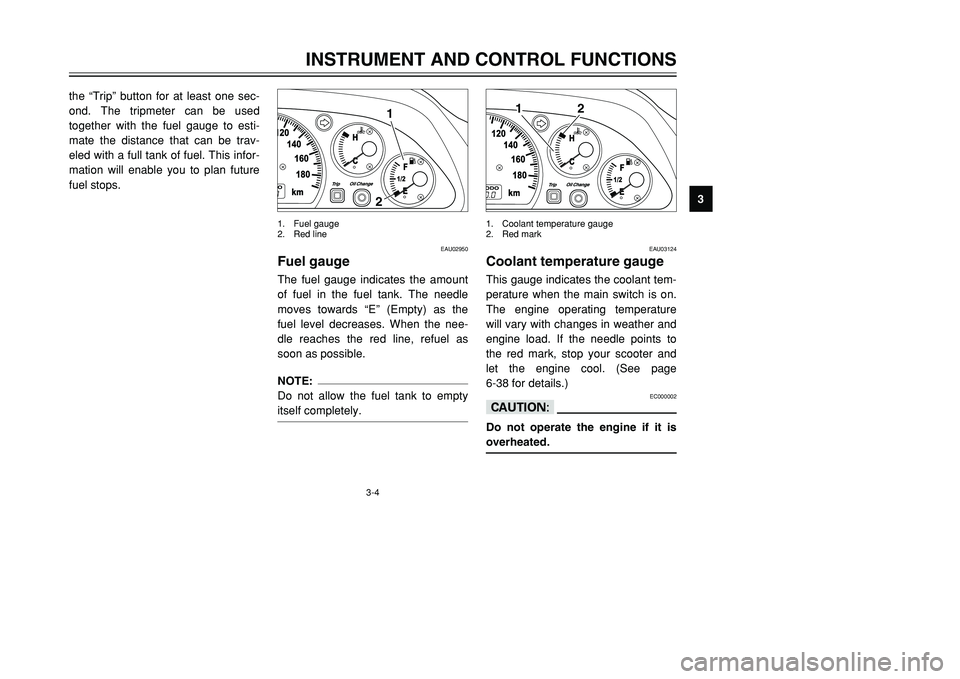
3-4
INSTRUMENT AND CONTROL FUNCTIONS
3 the “Trip” button for at least one sec-
ond. The tripmeter can be used
together with the fuel gauge to esti-
mate the distance that can be trav-
eled with a full tank of fuel. This infor-
mation will enable you to plan future
fuel stops.
EAU02950
Fuel gaugeFuel gaugeThe fuel gauge indicates the amount
of fuel in the fuel tank. The needle
moves towards “E” (Empty) as the
fuel level decreases. When the nee-
dle reaches the red line, refuel as
soon as possible.NOTE:
Do not allow the fuel tank to empty
itself completely.
12
1. Fuel gauge
2. Red line
EAU03124
Coolant temperature gaugeCoolant temperature gaugeThis gauge indicates the coolant tem-
perature when the main switch is on.
The engine operating temperature
will vary with changes in weather and
engine load. If the needle points to
the red mark, stop your scooter and
let the engine cool. (See page
6-38 for details.)
EC000002
cCDo not operate the engine if it is
overheated.
2
1
1. Coolant temperature gauge
2. Red mark
5GJ-9-E1 9/4/01 1:27 PM Page 19
Page 35 of 102
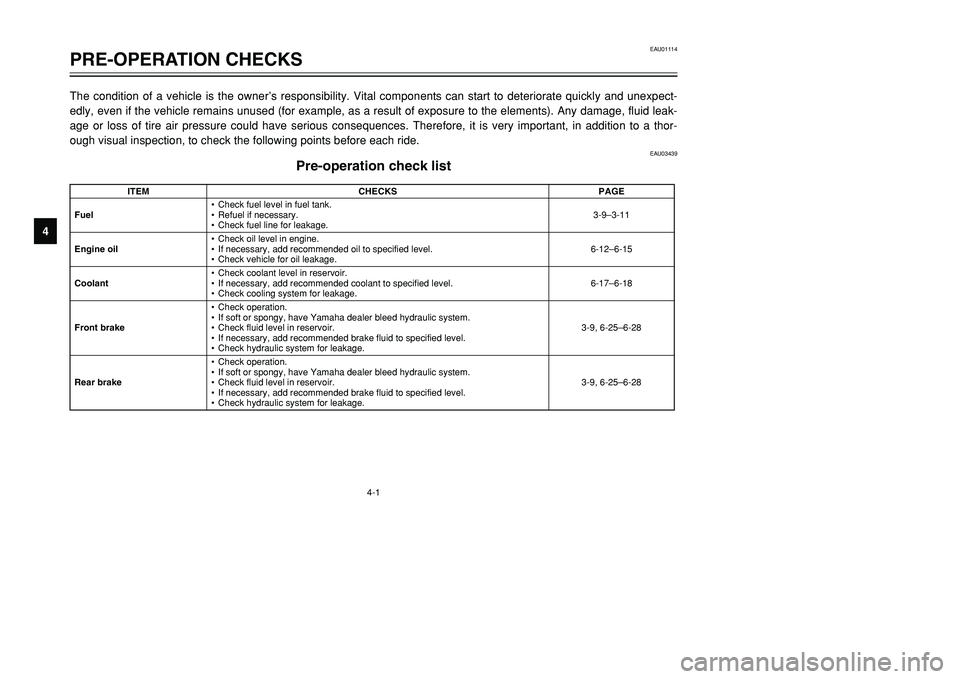
4-1
EAU01114
PRE-OPERATION CHECKS
4The condition of a vehicle is the owner’s responsibility. Vital components can start to deteriorate quickly and unexpect-
edly, even if the vehicle remains unused (for example, as a result of exposure to the elements). Any damage, fluid leak-
age or loss of tire air pressure could have serious consequences. Therefore, it is very important, in addition to a thor-
ough visual inspection, to check the following points before each ride.
EAU03439
Pre-operation check list
Pre-operation check list
ITEM CHECKS PAGE
Fuel•Check fuel level in fuel tank.
•Refuel if necessary.
•Check fuel line for leakage.3-9–3-11
Engine oil•Check oil level in engine.
•If necessary, add recommended oil to specified level.
•Check vehicle for oil leakage.6-12–6-15
Coolant•Check coolant level in reservoir.
•If necessary, add recommended coolant to specified level.
•Check cooling system for leakage.6-17–6-18
Front brake•Check operation.
•If soft or spongy, have Yamaha dealer bleed hydraulic system.
•Check fluid level in reservoir.
•If necessary, add recommended brake fluid to specified level.
•Check hydraulic system for leakage.3-9, 6-25–6-28
Rear brake•Check operation.
•If soft or spongy, have Yamaha dealer bleed hydraulic system.
•Check fluid level in reservoir.
•If necessary, add recommended brake fluid to specified level.
•Check hydraulic system for leakage.3-9, 6-25–6-28
5GJ-9-E1 9/4/01 1:27 PM Page 34
Page 44 of 102
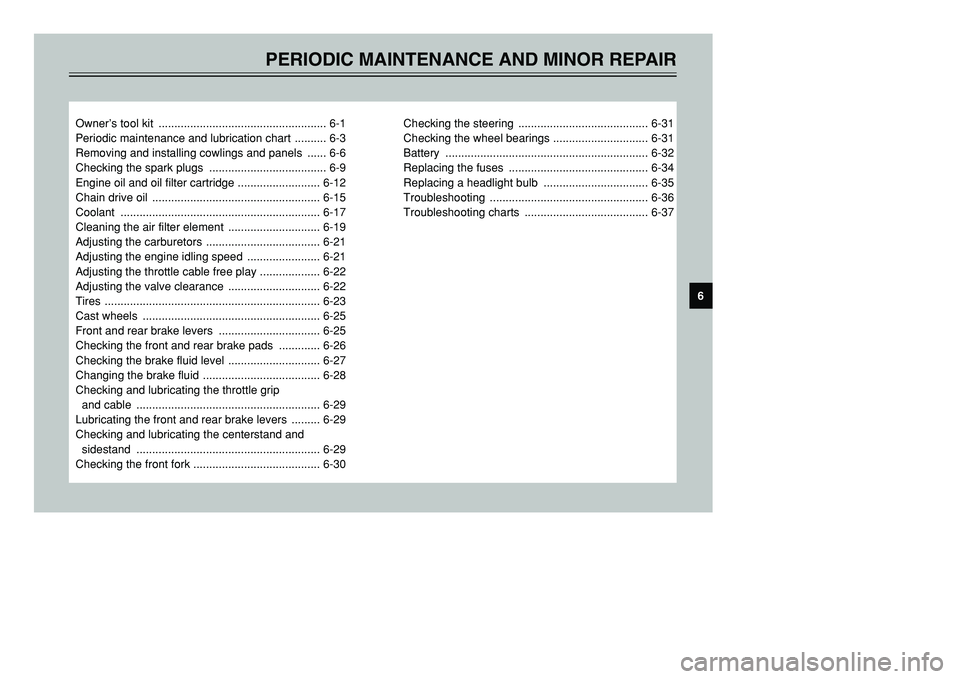
PERIODIC MAINTENANCE AND MINOR REPAIR
Owner’s tool kit ..................................................... 6-1
Periodic maintenance and lubrication chart .......... 6-3
Removing and installing cowlings and panels ...... 6-6
Checking the spark plugs ..................................... 6-9
Engine oil and oil filter cartridge .......................... 6-12
Chain drive oil ..................................................... 6-15
Coolant ............................................................... 6-17
Cleaning the air filter element ............................. 6-19
Adjusting the carburetors .................................... 6-21
Adjusting the engine idling speed ....................... 6-21
Adjusting the throttle cable free play ................... 6-22
Adjusting the valve clearance ............................. 6-22
Tires .................................................................... 6-23
Cast wheels ........................................................ 6-25
Front and rear brake levers ................................ 6-25
Checking the front and rear brake pads ............. 6-26
Checking the brake fluid level ............................. 6-27
Changing the brake fluid ..................................... 6-28
Checking and lubricating the throttle grip
and cable .......................................................... 6-29
Lubricating the front and rear brake levers ......... 6-29
Checking and lubricating the centerstand and
sidestand .......................................................... 6-29
Checking the front fork ........................................ 6-30Checking the steering ......................................... 6-31
Checking the wheel bearings .............................. 6-31
Battery ................................................................ 6-32
Replacing the fuses ............................................ 6-34
Replacing a headlight bulb ................................. 6-35
Troubleshooting .................................................. 6-36
Troubleshooting charts ....................................... 6-37
6
5GJ-9-E1 9/4/01 1:27 PM Page 43
Page 49 of 102
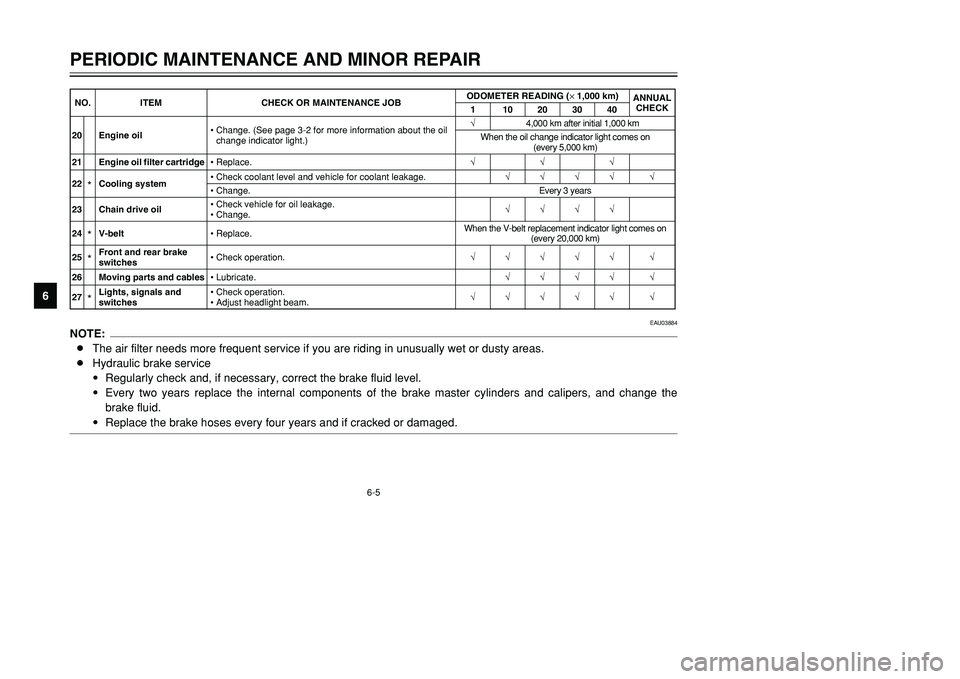
6-5
PERIODIC MAINTENANCE AND MINOR REPAIR
6
EAU03884
NOTE:
8The air filter needs more frequent service if you are riding in unusually wet or dusty areas.
8Hydraulic brake service
9Regularly check and, if necessary, correct the brake fluid level.
9Every two years replace the internal components of the brake master cylinders and calipers, and change the
brake fluid.
9Replace the brake hoses every four years and if cracked or damaged.20 Engine oil•Change. (See page 3-2 for more information about the oil
change indicator light.)√4,000 km after initial 1,000 km
When the oil change indicator light comes on
(every 5,000 km)
21 Engine oil filter cartridge•Replace.√√√
22
*Cooling system•Check coolant level and vehicle for coolant leakage.√√√√ √
•Change.Every 3 years
23 Chain drive oil•Check vehicle for oil leakage.
•Change.√√√√
24*V-belt•Replace.When the V-belt replacement indicator light comes on
(every 20,000 km)
25*Front and rear brake
switches•Check operation.√√√√√ √
26 Moving parts and cables•Lubricate.√√√√ √
27*Lights, signals and
switches•Check operation.
•Adjust headlight beam.√√√√√ √ NO. ITEM CHECK OR MAINTENANCE JOBODOMETER READING (× 1,000 km)
ANNUAL
CHECK
1 10203040
5GJ-9-E1 9/4/01 1:27 PM Page 48
Page 61 of 102
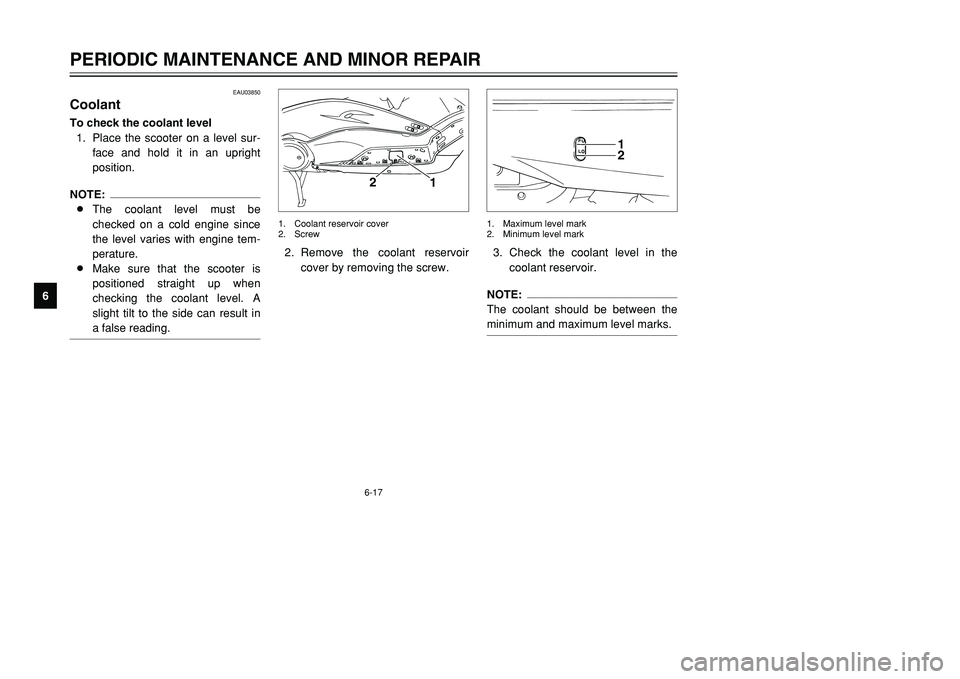
6-17
PERIODIC MAINTENANCE AND MINOR REPAIR
6
EAU03850
CoolantCoolantTo check the coolant level
1. Place the scooter on a level sur-
face and hold it in an upright
position.NOTE:
8The coolant level must be
checked on a cold engine since
the level varies with engine tem-
perature.
8Make sure that the scooter is
positioned straight up when
checking the coolant level. A
slight tilt to the side can result in
a false reading.
3. Check the coolant level in the
coolant reservoir.NOTE:
The coolant should be between the
minimum and maximum level marks.
12
1. Maximum level mark
2. Minimum level mark
2. Remove the coolant reservoir
cover by removing the screw.
1
2
1. Coolant reservoir cover
2. Screw
5GJ-9-E1 9/4/01 1:27 PM Page 60
Page 62 of 102
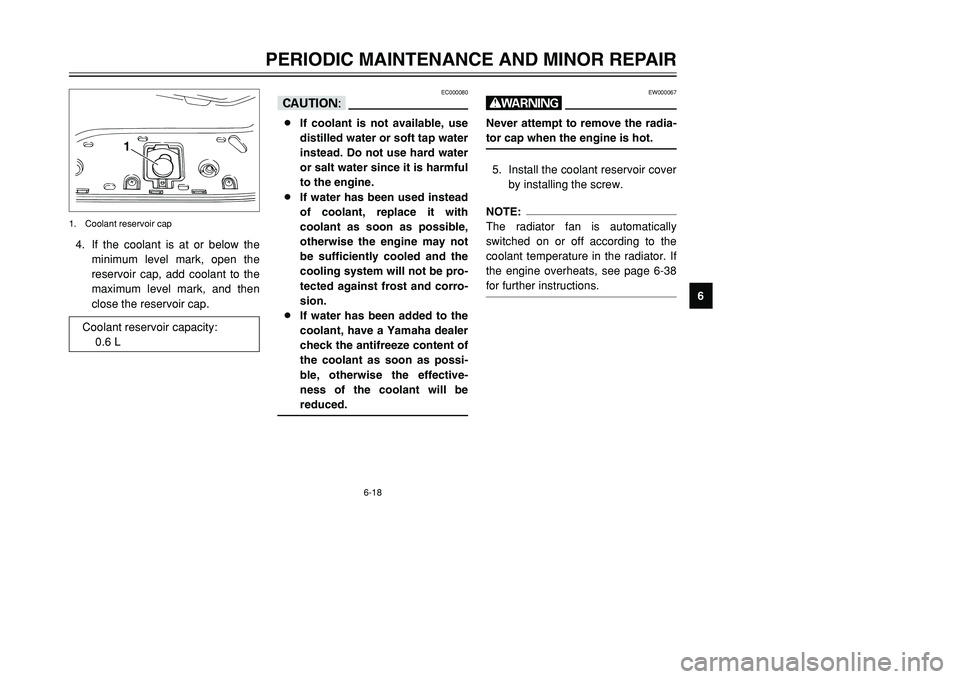
6-18
PERIODIC MAINTENANCE AND MINOR REPAIR
6 4. If the coolant is at or below the
minimum level mark, open the
reservoir cap, add coolant to the
maximum level mark, and then
close the reservoir cap.
1
1. Coolant reservoir cap
EW000067
wNever attempt to remove the radia-
tor cap when the engine is hot.5. Install the coolant reservoir cover
by installing the screw.NOTE:
The radiator fan is automatically
switched on or off according to the
coolant temperature in the radiator. If
the engine overheats, see page 6-38
for further instructions.
EC000080
cC8If coolant is not available, use
distilled water or soft tap water
instead. Do not use hard water
or salt water since it is harmful
to the engine.
8If water has been used instead
of coolant, replace it with
coolant as soon as possible,
otherwise the engine may not
be sufficiently cooled and the
cooling system will not be pro-
tected against frost and corro-
sion.
8If water has been added to the
coolant, have a Yamaha dealer
check the antifreeze content of
the coolant as soon as possi-
ble, otherwise the effective-
ness of the coolant will be
reduced.
Coolant reservoir capacity:
0.6 L
5GJ-9-E1 9/4/01 1:27 PM Page 61
Page 82 of 102
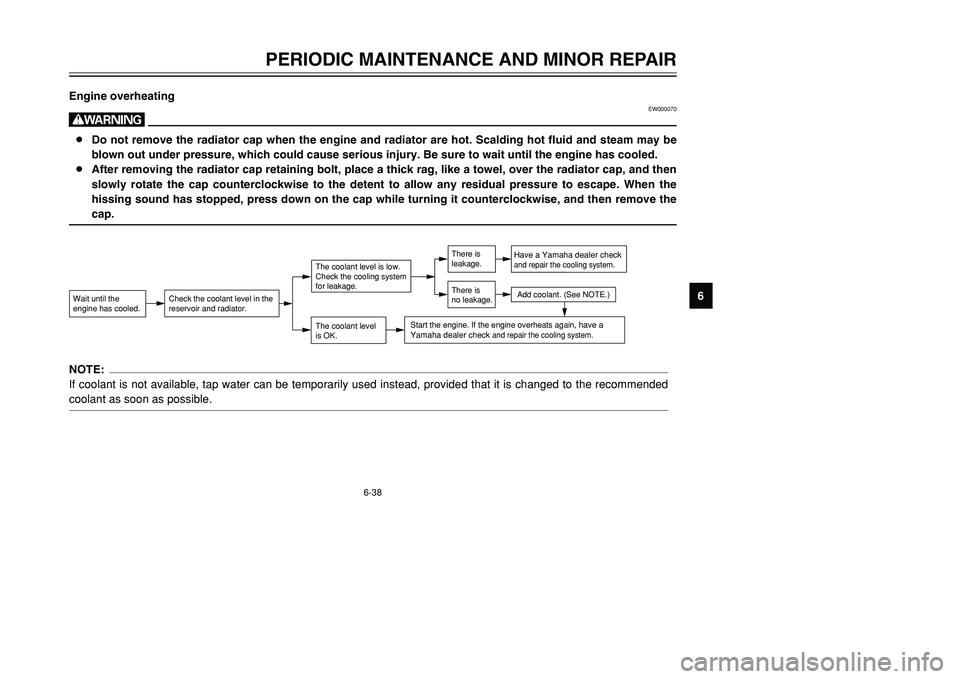
6-38
PERIODIC MAINTENANCE AND MINOR REPAIR
6 Engine overheating
EW000070
w8Do not remove the radiator cap when the engine and radiator are hot. Scalding hot fluid and steam may be
blown out under pressure, which could cause serious injury. Be sure to wait until the engine has cooled.
8After removing the radiator cap retaining bolt, place a thick rag, like a towel, over the radiator cap, and then
slowly rotate the cap counterclockwise to the detent to allow any residual pressure to escape. When the
hissing sound has stopped, press down on the cap while turning it counterclockwise, and then remove the
cap.Wait until the
engine has cooled.
Check the coolant level in the
reservoir and radiator.
The coolant level
is OK.The coolant level is low.
Check the cooling system
for leakage.
Have a Yamaha dealer checkand repair the cooling system.Add coolant. (See NOTE.)
Start the engine. If the engine overheats again,
have a
Yamaha dealer check
and repair the cooling system.
There is
leakage.
There is
no leakage.
NOTE:
If coolant is not available, tap water can be temporarily used instead, provided that it is changed to the recommended
coolant as soon as possible.
5GJ-9-E1 9/4/01 1:27 PM Page 81
Page 99 of 102
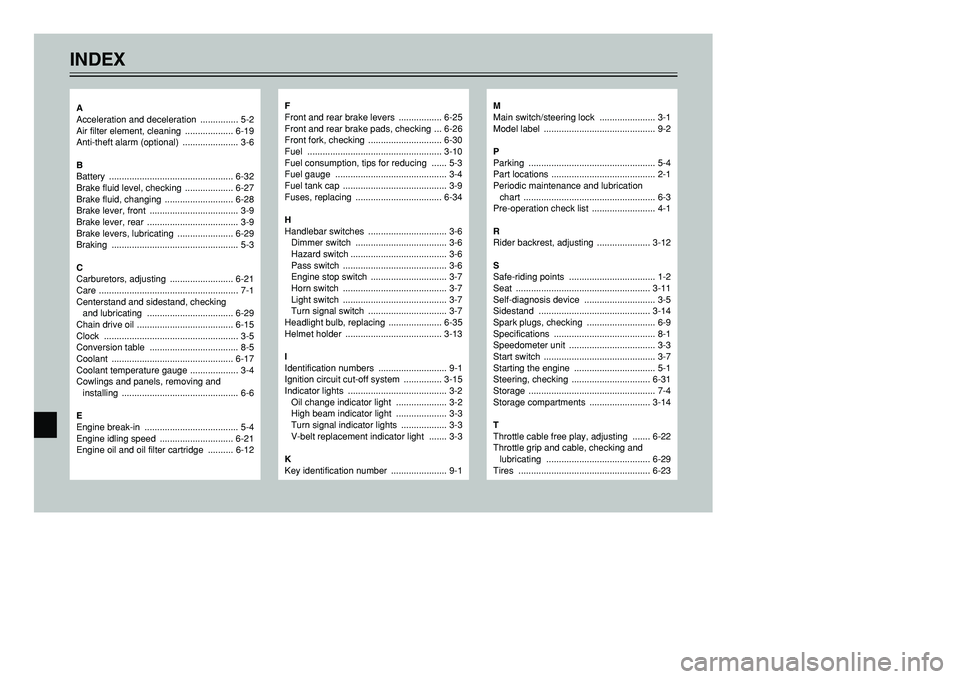
INDEX
F
Front and rear brake levers ................. 6-25
Front and rear brake pads, checking ... 6-26
Front fork, checking ............................. 6-30
Fuel ..................................................... 3-10
Fuel consumption, tips for reducing ...... 5-3
Fuel gauge ............................................ 3-4
Fuel tank cap ......................................... 3-9
Fuses, replacing .................................. 6-34
H
Handlebar switches ............................... 3-6
Dimmer switch .................................... 3-6
Hazard switch ...................................... 3-6
Pass switch ......................................... 3-6
Engine stop switch .............................. 3-7
Horn switch ......................................... 3-7
Light switch ......................................... 3-7
Turn signal switch ............................... 3-7
Headlight bulb, replacing ..................... 6-35
Helmet holder ...................................... 3-13
I
Identification numbers ........................... 9-1
Ignition circuit cut-off system ............... 3-15
Indicator lights ....................................... 3-2
Oil change indicator light .................... 3-2
High beam indicator light .................... 3-3
Turn signal indicator lights .................. 3-3
V-belt replacement indicator light ....... 3-3
K
Key identification number ...................... 9-1
M
Main switch/steering lock ...................... 3-1
Model label ............................................ 9-2
P
Parking .................................................. 5-4
Part locations ......................................... 2-1
Periodic maintenance and lubrication
chart .................................................... 6-3
Pre-operation check list ......................... 4-1
R
Rider backrest, adjusting ..................... 3-12
S
Safe-riding points .................................. 1-2
Seat ..................................................... 3-11
Self-diagnosis device ............................ 3-5
Sidestand ............................................ 3-14
Spark plugs, checking ........................... 6-9
Specifications ........................................ 8-1
Speedometer unit .................................. 3-3
Start switch ............................................ 3-7
Starting the engine ................................ 5-1
Steering, checking ............................... 6-31
Storage .................................................. 7-4
Storage compartments ........................ 3-14
T
Throttle cable free play, adjusting ....... 6-22
Throttle grip and cable, checking and
lubricating ......................................... 6-29
Tires .................................................... 6-23
A
Acceleration and deceleration ............... 5-2
Air filter element, cleaning ................... 6-19
Anti-theft alarm (optional) ...................... 3-6
B
Battery ................................................. 6-32
Brake fluid level, checking ................... 6-27
Brake fluid, changing ........................... 6-28
Brake lever, front ................................... 3-9
Brake lever, rear .................................... 3-9
Brake levers, lubricating ...................... 6-29
Braking .................................................. 5-3
C
Carburetors, adjusting ......................... 6-21
Care ....................................................... 7-1
Centerstand and sidestand, checking
and lubricating .................................. 6-29
Chain drive oil ...................................... 6-15
Clock ..................................................... 3-5
Conversion table ................................... 8-5
Coolant ................................................ 6-17
Coolant temperature gauge ................... 3-4
Cowlings and panels, removing and
installing .............................................. 6-6
E
Engine break-in ..................................... 5-4
Engine idling speed ............................. 6-21
Engine oil and oil filter cartridge .......... 6-12
5GJ-9-E1 9/4/01 1:27 PM Page 98